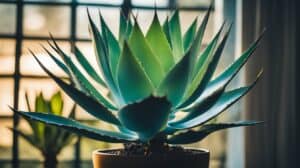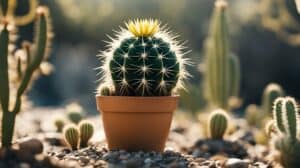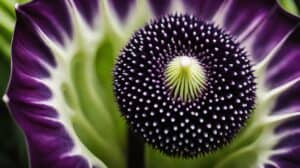Asclepias Tuberosa, also known as Butterfly Weed, is a species of milkweed that is native to North America.
This vibrant orange wildflower is a favorite of many gardeners and nature enthusiasts, not only for its beauty but also for its ability to attract one of the most beloved insects in the world – the monarch butterfly.

Monarch butterflies are known for their stunning orange and black wings, and they play an important role in our ecosystem as pollinators.
However, their populations have been declining in recent years due to habitat loss and the use of pesticides.
This is where Asclepias Tuberosa comes in – it is a crucial host plant for monarchs, providing them with a place to lay their eggs and a source of food for their caterpillars.
In this article, we will explore the many benefits of planting Asclepias Tuberosa in your garden, and how you can attract monarch butterflies to your yard by creating a monarch-friendly habitat.
From the best planting practices to tips on caring for your butterfly weed, we will cover everything you need to know to create a beautiful and sustainable garden that supports monarch butterfly conservation.
Understanding Asclepias Tuberosa
Botanical Profile
Asclepias Tuberosa, commonly known as Butterfly Weed, is a species of milkweed native to North America.
It is a perennial plant that can grow up to 2 feet tall and 1.5 feet wide. The plant has a deep taproot and a thick stem that is covered with fine hairs.
The leaves are narrow and lance-shaped, and they grow up to 6 inches long.
The flowers are bright orange or yellow, and they bloom in clusters from June to August.
Butterfly Weed is an important plant for pollinators, especially Monarch butterflies.
The plant contains a toxic sap that Monarch caterpillars can ingest without harm.
The caterpillars use the plant as a food source, and the adult butterflies use it as a nectar source.
Habitat and Growth Requirements
Butterfly Weed is a hardy plant that can grow in a variety of soil types, including sandy, rocky, and clay soils.
It prefers well-drained soil and full sun, but it can tolerate some shade.
The plant is drought-tolerant once established, but it will benefit from regular watering during dry spells.
Butterfly Weed is commonly found in prairies, meadows, and along roadsides. It is also a popular plant for gardens and landscaping.
The plant can be propagated by seed or by dividing the root ball in the fall or spring.
Overall, Asclepias Tuberosa is a beautiful and important plant for pollinators, especially Monarch butterflies.
By understanding its botanical profile and growth requirements, gardeners and nature enthusiasts can attract and support these important insects in their local ecosystems.
The Role in Monarch Conservation

Monarch Butterfly Lifecycle
Asclepias tuberosa, commonly known as butterfly weed, plays a crucial role in the lifecycle of monarch butterflies.
Monarchs lay their eggs on the leaves of milkweed plants, and the caterpillars that hatch from these eggs feed exclusively on milkweed leaves.
The milkweed provides the necessary nutrients for the caterpillars to grow and develop into adult butterflies.
Without milkweed, monarchs would not be able to complete their lifecycle, and their populations would decline.
Importance of Milkweed
The decline in milkweed populations is one of the main factors contributing to the decline in monarch populations.
The loss of milkweed habitat due to land development, herbicide use, and other factors has led to a significant decrease in milkweed populations across North America.
By planting Asclepias tuberosa, individuals can help provide important habitat for monarchs and contribute to their conservation.
Butterfly weed is a particularly important milkweed species because it is easy to grow and maintain, making it an accessible option for individuals looking to contribute to monarch conservation efforts.
Additionally, butterfly weed produces bright orange flowers that attract both monarchs and other pollinators, making it a valuable addition to any garden or landscape.
In conclusion, Asclepias tuberosa, or butterfly weed, plays a critical role in the conservation of monarch butterflies.
By providing important habitat for monarchs and other pollinators, butterfly weed can help support healthy ecosystems and contribute to the preservation of these iconic butterflies.
Cultivating Butterfly Weed

Planting Guidelines
Butterfly weed, also known as Asclepias tuberosa, is a beautiful and easy-to-grow perennial plant that is native to North America.
If you’re interested in attracting monarch butterflies to your garden, butterfly weed is an excellent choice.
Here are some planting guidelines to help you get started:
- Location: Butterfly weed prefers full sun and well-drained soil.
It can tolerate some drought, but it doesn’t like wet feet, so make sure the soil is not too moist.
- Planting Time: Butterfly weed can be planted in the spring or fall.
If you’re planting in the spring, wait until the soil has warmed up and there is no danger of frost.
If you’re planting in the fall, do it at least six weeks before the first frost.
- Spacing: Plant butterfly weed about 18-24 inches apart.
It grows to be about 2-3 feet tall and wide, so make sure you give it enough room to spread out.
- Soil Preparation: Butterfly weed doesn’t require much fertilizer, but it does appreciate well-drained soil.
If your soil is heavy or clay-like, add some compost or sand to improve drainage.
Maintenance and Care
Once you’ve planted your butterfly weed, it’s important to take good care of it to ensure that it thrives and attracts monarch butterflies.
Here are some maintenance and care tips:
- Watering: Butterfly weed is drought-tolerant, but it still needs water to grow and flower.
Water it deeply once a week during dry spells.
- Mulching: Mulch around the base of the plant to help retain moisture and suppress weeds.
Use organic mulch like shredded leaves or bark.
- Deadheading: Deadhead the flowers as they fade to encourage more blooms and prevent self-seeding.
- Cutting Back: In the fall, after the first frost, cut back the dead stems to about 6 inches above the ground.
This will help the plant come back strong in the spring.
- Pest Control: Butterfly weed is generally pest-free, but it can be susceptible to aphids and milkweed bugs.
If you notice an infestation, spray the plant with a strong stream of water or use an insecticidal soap.
By following these planting and care guidelines, you can cultivate a beautiful and healthy butterfly weed plant that will attract monarch butterflies to your garden.
Challenges and Solutions

Pest and Disease Management
Asclepias tuberosa is generally a hardy plant, but it can be susceptible to some pests and diseases.
One common problem is aphids, which can be controlled by spraying the plant with a strong stream of water or using insecticidal soap.
Another issue is the milkweed beetle, which can be handpicked or treated with insecticidal soap.
Disease is less of an issue with Asclepias tuberosa, but it can be vulnerable to fungal infections in humid conditions.
To prevent this, it is important to avoid overhead watering and to ensure proper air circulation around the plant.
If fungal infection does occur, a fungicide can be used to treat the plant.
Environmental Stress Factors
Asclepias tuberosa is a plant that thrives in full sun and well-drained soil. However, it can struggle in extreme heat or drought conditions.
To combat this, it is important to water the plant deeply and regularly during dry spells and to provide shade during periods of extreme heat.
Another environmental stress factor is soil quality.
Asclepias tuberosa prefers well-drained soil, and can be susceptible to root rot if planted in heavy clay soil.
To avoid this, it is recommended to amend the soil with organic matter such as compost or peat moss before planting.
By understanding and addressing these challenges, gardeners can successfully cultivate Asclepias tuberosa and attract monarch butterflies to their gardens.
Frequently Asked Questions

How can I effectively grow Asclepias tuberosa to attract monarch butterflies?
Asclepias tuberosa, commonly known as butterfly weed, is a native perennial plant that is easy to grow.
To attract monarch butterflies, it is important to plant the butterfly weed in a sunny location, as monarchs prefer sunny spots.
The soil should be well-draining, and the plant should be watered regularly.
It is also important to avoid using pesticides, as they can harm monarchs and other pollinators.
What care tips are essential for maintaining healthy butterfly weed plants?
Butterfly weed plants require little maintenance once established.
However, it is important to water them regularly during the first growing season to help them establish a strong root system.
After that, they are drought-tolerant and require little watering. Deadheading spent blooms can encourage the plant to produce more flowers.
In the fall, the plant should be cut back to a few inches above the ground to prepare for winter.
Can you start Asclepias tuberosa from seeds, and if so, how?
Yes, Asclepias tuberosa can be started from seeds.
The seeds should be planted in the fall or early spring, as they require a period of cold stratification to germinate.
The seeds should be sown on the surface of well-draining soil, and lightly covered with soil.
The soil should be kept moist until the seeds germinate, which can take up to a month.
What is the native range of Asclepias tuberosa, and why is it important?
Asclepias tuberosa is native to North America, and can be found in a wide range of habitats, from prairies to woodlands.
It is an important plant for monarch butterflies, as it is one of the few plants that monarch caterpillars can eat.
By planting native plants like butterfly weed, gardeners can help support local ecosystems and pollinators.
When can I expect my butterfly weed to start blooming?
Butterfly weed typically blooms from June to August, depending on the location and climate. In warmer climates, it may bloom earlier in the year.
The plant produces bright orange flowers that are attractive to pollinators like butterflies and bees.
What other pollinators are attracted to butterfly weed besides monarchs?
Butterfly weed is a favorite of many pollinators, including bees, wasps, and other butterflies.
It is an important plant for supporting local ecosystems and promoting biodiversity.














